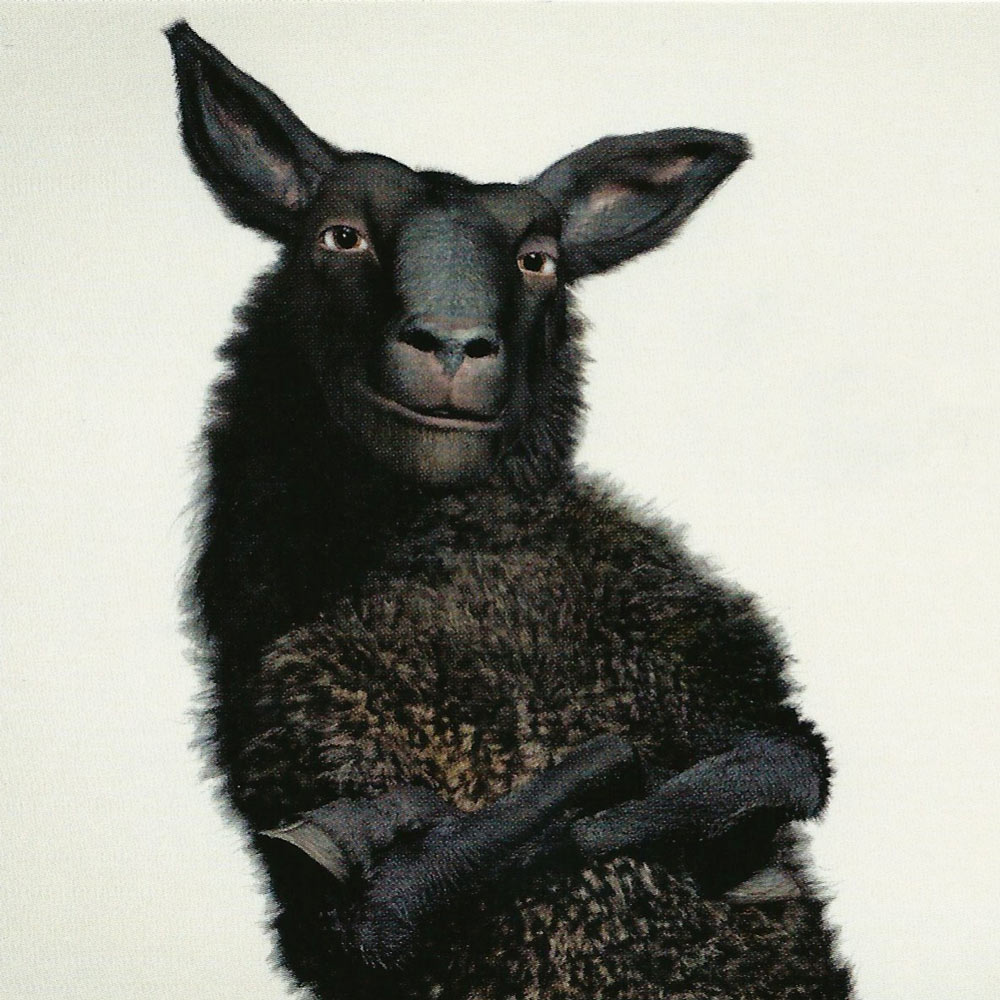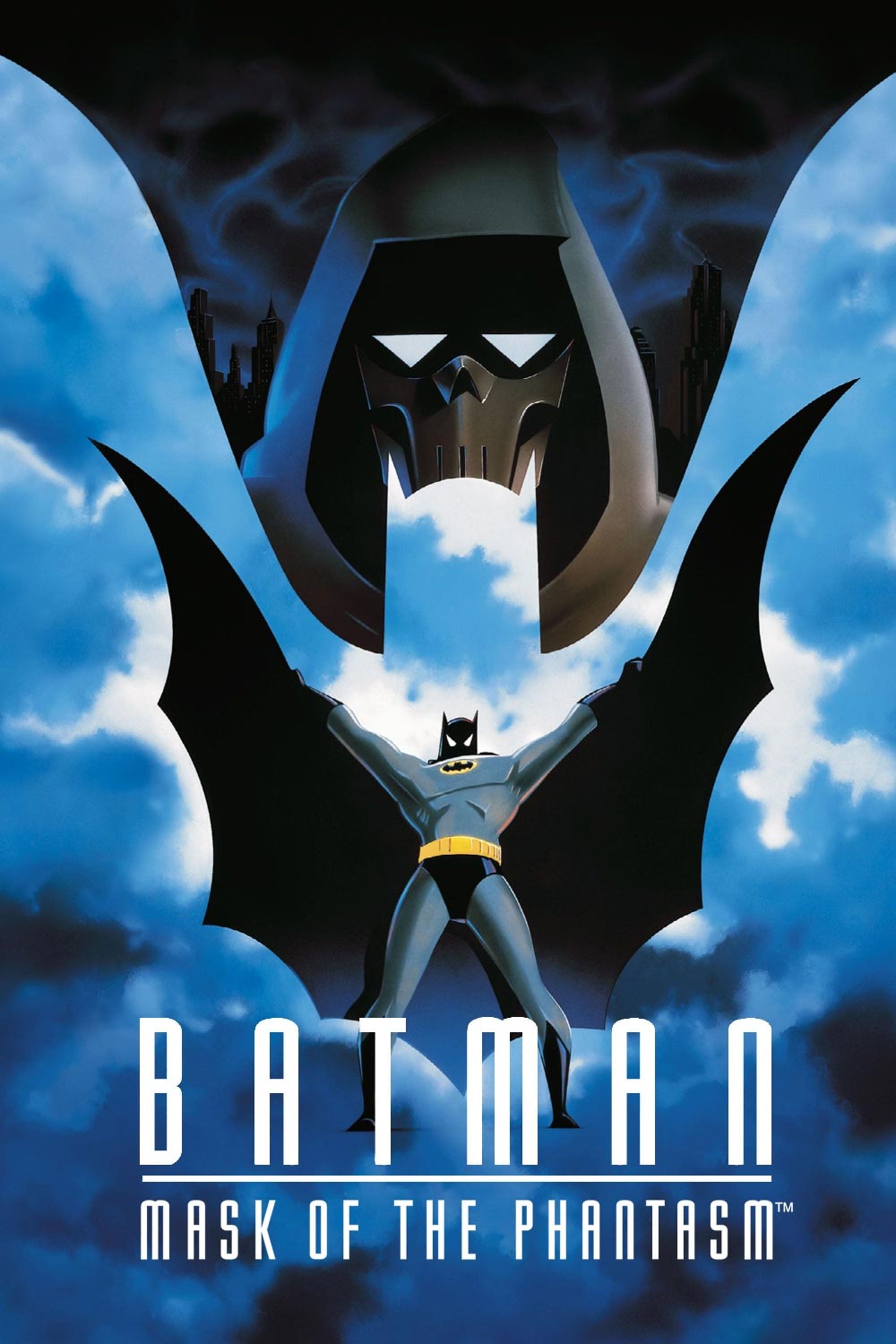Published on
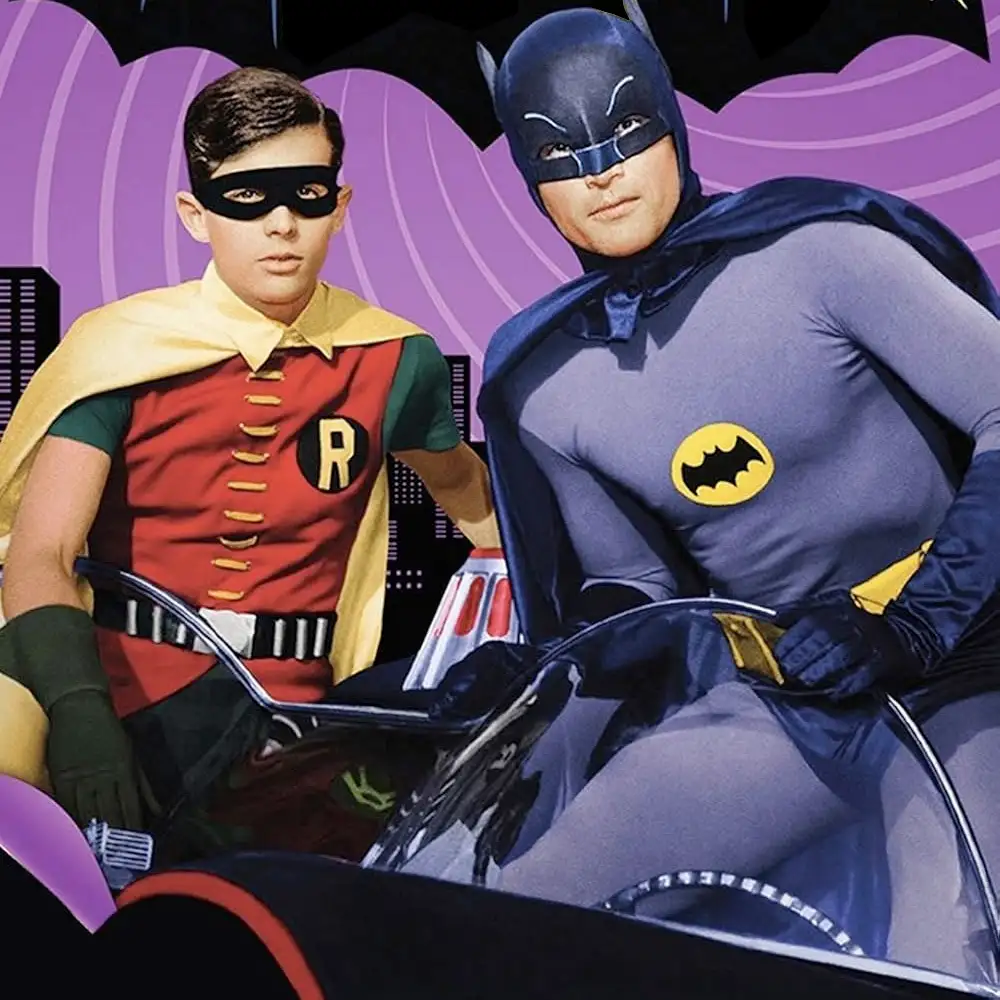
writeWhen people think of Batman today, they picture the Dark Knight — the caped crusader clad in black, battling crime under Gotham’s dimly lit skies. And for many, when it comes to animated versions, the definitive take is the classic animated series, known for its striking art style that began with black paper backgrounds. But before Tim Burton’s 1989 film redefined Batman as a dark, brooding figure, the character was best known for something entirely different: the colorful, campy world of the 1960s TV show, simply titled “Batman”.
In the colorful and delightfully campy 1960s TV series “Batman”, millionaire Bruce Wayne and his youthful ward Dick Grayson lead secret double lives as the caped crusaders Batman and Robin. Together, they defend Gotham City from a revolving gallery of flamboyant villains — including the Joker, the Riddler, the Penguin, and Catwoman. With help from their ever-reliable butler Alfred and the steadfast Commissioner Gordon, the Dynamic Duo thwarts over-the-top criminal schemes using clever gadgets, quick-witted puns, and a firm sense of moral justice. Each episode often ended on a cliffhanger resolved in the next installment, complete with the show’s trademark onomatopoeic fight scenes and tongue-in-cheek humor that cemented “Batman” as a true pop culture phenomenon.
I grew up watching this show in the 1980s during one of its many television reruns. It was my first real introduction to the world of superheroes—a world that, at the time, was bright, colorful, and full of larger-than-life characters. While the 1980s gradually gave way to darker and more mature interpretations of the genre, especially by the decade’s end with Batman leading that shift, the campy and vibrant 1960s series was still what most people associated with the character.
It’s now well known that many Batman fans in the ’80s were outraged when Michael Keaton—then best known for his comedic roles—was cast as Bruce Wayne, fearing his portrayal would resemble the tongue-in-cheek tone of the 1960s show. So it’s fair to say not everyone has a soft spot for this version of Batman. And honestly, it’s easy to understand why: as much of a cultural milestone as it is, this is a series that’s impossible to take seriously, clearly aimed at a younger, pre-teen audience.
The show consists of 120 episodes, each about 25 minutes long, typically structured as two-part stories. The first episode would usually end on a dramatic cliffhanger, punctuated by the narrator’s famous line: “Tune in tomorrow night—same Bat-time, same Bat-channel!” Each two-parter featured a special guest star as that week’s villain, contributing to the show’s revolving door of colorful adversaries. While iconic foes like the Penguin, the Joker, the Riddler, and Catwoman appeared multiple times—often within the same season—others such as Zelda the Great, Bookworm, and False Face only made a single, but occasionally memorable, appearance.
 Revisiting this show, what’s most surprising is how many of the elements that made it so memorable are present right from the very beginning. Many series take a few episodes—or even entire seasons—to really find their footing, but Batman had its formula nailed down from the first two-parter. Everything that defines the show is already there: the campy story structure, the deliberately hokey acting, and the charming little details like every object being clearly labeled, the Dutch angles used for villain hideouts, and of course, the iconic “POWs” and “ZAPs” flashing across every fight scene.
Revisiting this show, what’s most surprising is how many of the elements that made it so memorable are present right from the very beginning. Many series take a few episodes—or even entire seasons—to really find their footing, but Batman had its formula nailed down from the first two-parter. Everything that defines the show is already there: the campy story structure, the deliberately hokey acting, and the charming little details like every object being clearly labeled, the Dutch angles used for villain hideouts, and of course, the iconic “POWs” and “ZAPs” flashing across every fight scene.
The only real evolution during that first season was the closing narration at the end of each cliffhanger. What began as the simple “same time, same channel” soon transformed into the now-iconic “same Bat-time, same Bat-channel”. Quite the upgrade.
Having not seen this show in over 30 years, I was surprised by how many iconic moments still stuck in my memory. Images like Aunt Harriet dangling above a fire or a giant book placed in the middle of the street have somehow lingered all these years. Both of these moments appear in the first season—a testament to how instantly memorable the show was right from the start. Though “good” might not be the perfect word for it, because viewed through adult eyes, the show is undeniably silly—delightfully so, but silly nonetheless.
 It’s no surprise that both Adam West and Burt Ward struggled to find steady acting work after Batman. As Bruce Wayne and Dick Grayson, their screen time in the series is surprisingly limited—often appearing only in the opening scenes, and sometimes not even in the closing moments of a story. There are a few exceptions, such as the first Penguin episode, where Bruce Wayne visits the villain’s umbrella shop and ends up in the cliffhanger himself. Similarly, one Joker episode set at Dick Grayson’s high school offers a rare glimpse into the Boy Wonder’s everyday life outside the Batcave.
It’s no surprise that both Adam West and Burt Ward struggled to find steady acting work after Batman. As Bruce Wayne and Dick Grayson, their screen time in the series is surprisingly limited—often appearing only in the opening scenes, and sometimes not even in the closing moments of a story. There are a few exceptions, such as the first Penguin episode, where Bruce Wayne visits the villain’s umbrella shop and ends up in the cliffhanger himself. Similarly, one Joker episode set at Dick Grayson’s high school offers a rare glimpse into the Boy Wonder’s everyday life outside the Batcave.
Most of the time, though, both actors are in costume, fully committed to the show’s famously exaggerated, hokey acting style—something partly dictated by the campy dialogue they were given. Batman is portrayed as incorruptible and morally upright, occasionally pausing mid-action to correct Robin on trivial matters like always remembering to wear a seatbelt. Unfortunately, Burt Ward’s Robin often gets the short end of the stick. His dialogue is mostly reactionary—usually reduced to “You’re right, Batman!” or one of his many “Holy [situation-appropriate noun]!” exclamations. It doesn’t leave much room for depth. Some of that limitation lies in the writing, but part of it comes from Ward himself, who plays Dick Grayson with nearly the same exaggerated enthusiasm as Robin, missing opportunities to add more nuance or contrast between the two personas.
One of the most striking aspects of the 1960s Batman series is how it handles the character’s relationship with law enforcement and his public persona. In modern interpretations, Batman is typically portrayed as a vigilante who operates outside the law—someone who works with Commissioner Gordon out of necessity rather than official recognition. In films like The Batman, his presence at a crime scene is met with suspicion or outright hostility from the police.
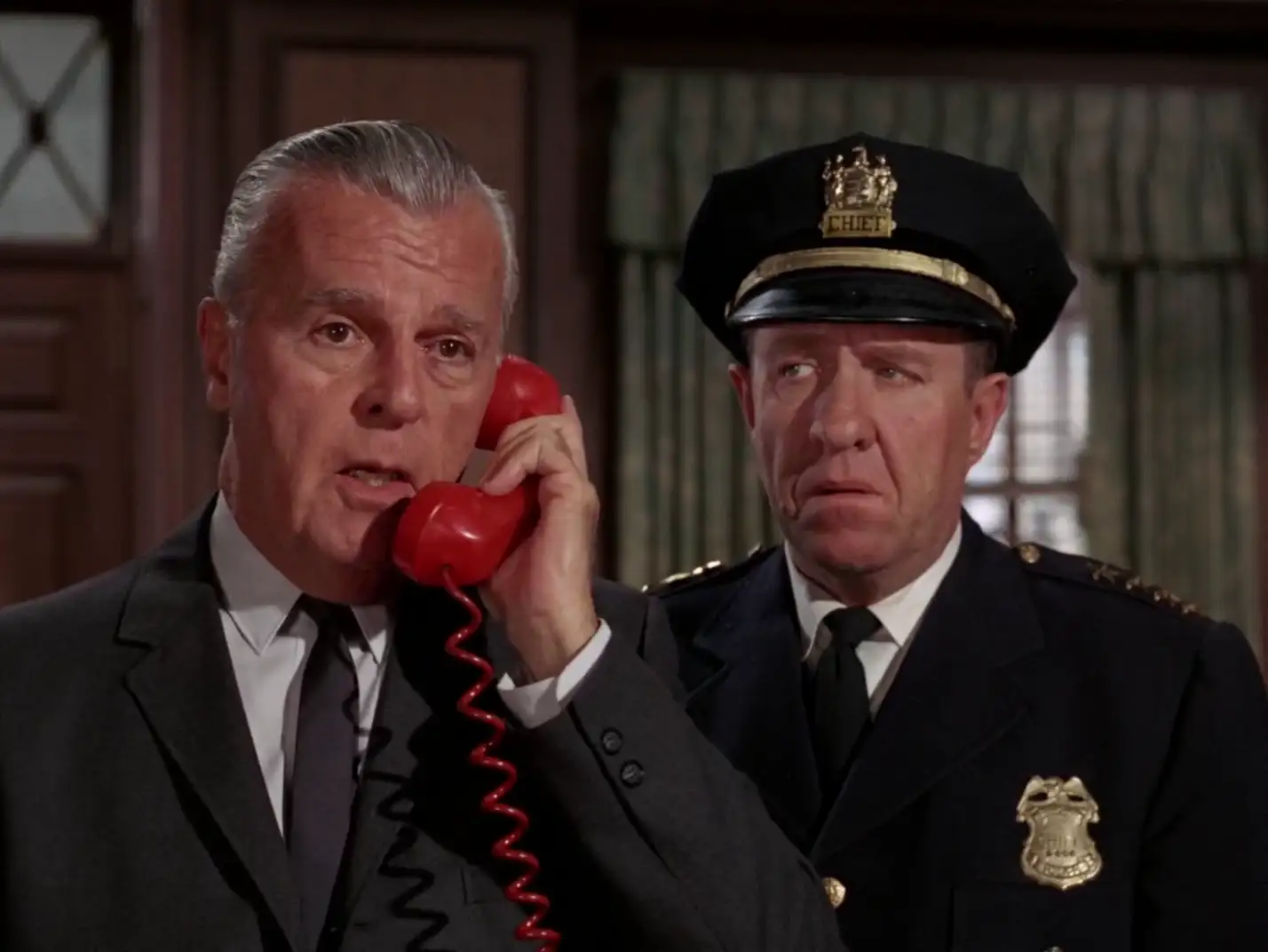 In stark contrast, the Batman of the 1960s is a celebrated public figure—a local hero and civic icon. Everyone in Gotham seems to know and respect him. Nobody bats an eye at the sight of two masked men in brightly colored spandex casually patrolling the city. Batman functions almost like a senior officer within the police force, giving orders that everyone, including the police themselves, obediently follows. He strolls into Gotham City Police Headquarters through the front door, greeted warmly by everyone, and serves as the city’s go-to problem solver.
In stark contrast, the Batman of the 1960s is a celebrated public figure—a local hero and civic icon. Everyone in Gotham seems to know and respect him. Nobody bats an eye at the sight of two masked men in brightly colored spandex casually patrolling the city. Batman functions almost like a senior officer within the police force, giving orders that everyone, including the police themselves, obediently follows. He strolls into Gotham City Police Headquarters through the front door, greeted warmly by everyone, and serves as the city’s go-to problem solver.
Whenever a themed villain strikes, Commissioner Gordon and Chief O’Hara don’t even bother with standard police procedure—they immediately reach for the Batphone. And speaking of O’Hara, he might just be the most ineffective police officer ever portrayed on television. On the rare occasions he actually takes action, he’s inevitably late to the scene, showing up only to arrest the villain Batman has already knocked out.
Villains
 Most of the villains in the 1960s Batman series feel like variations on the Riddler—at least throughout the first two seasons. The Riddler’s trademark gimmick is leaving behind a riddle at every crime scene, offering a clue to his next target or scheme. But in this show, that concept was clearly contagious. The Joker is essentially the Riddler with jokes instead of riddles, Bookworm is the Riddler with literary quotes, False Face uses nearly identical clue-based tricks, and the Puzzler is quite literally a Riddler knockoff in all but name.
Most of the villains in the 1960s Batman series feel like variations on the Riddler—at least throughout the first two seasons. The Riddler’s trademark gimmick is leaving behind a riddle at every crime scene, offering a clue to his next target or scheme. But in this show, that concept was clearly contagious. The Joker is essentially the Riddler with jokes instead of riddles, Bookworm is the Riddler with literary quotes, False Face uses nearly identical clue-based tricks, and the Puzzler is quite literally a Riddler knockoff in all but name.
Unlike modern superhero stories, which often dwell on origin stories for both heroes and villains, this show skips that entirely. Batman’s tragic backstory—the murder of his parents—is mentioned only once in passing. Robin and Batgirl’s motivations for donning their costumes are never addressed. Similarly, every villain appears as a fully formed nemesis from the outset, with Batman, Robin, Gordon, and O’Hara frequently referring to them as returning offenders. This approach not only streamlined the storytelling but also made it easy for episodes to air in any order during reruns—though it’s debatable whether anyone in 1966 was even thinking about syndication yet.
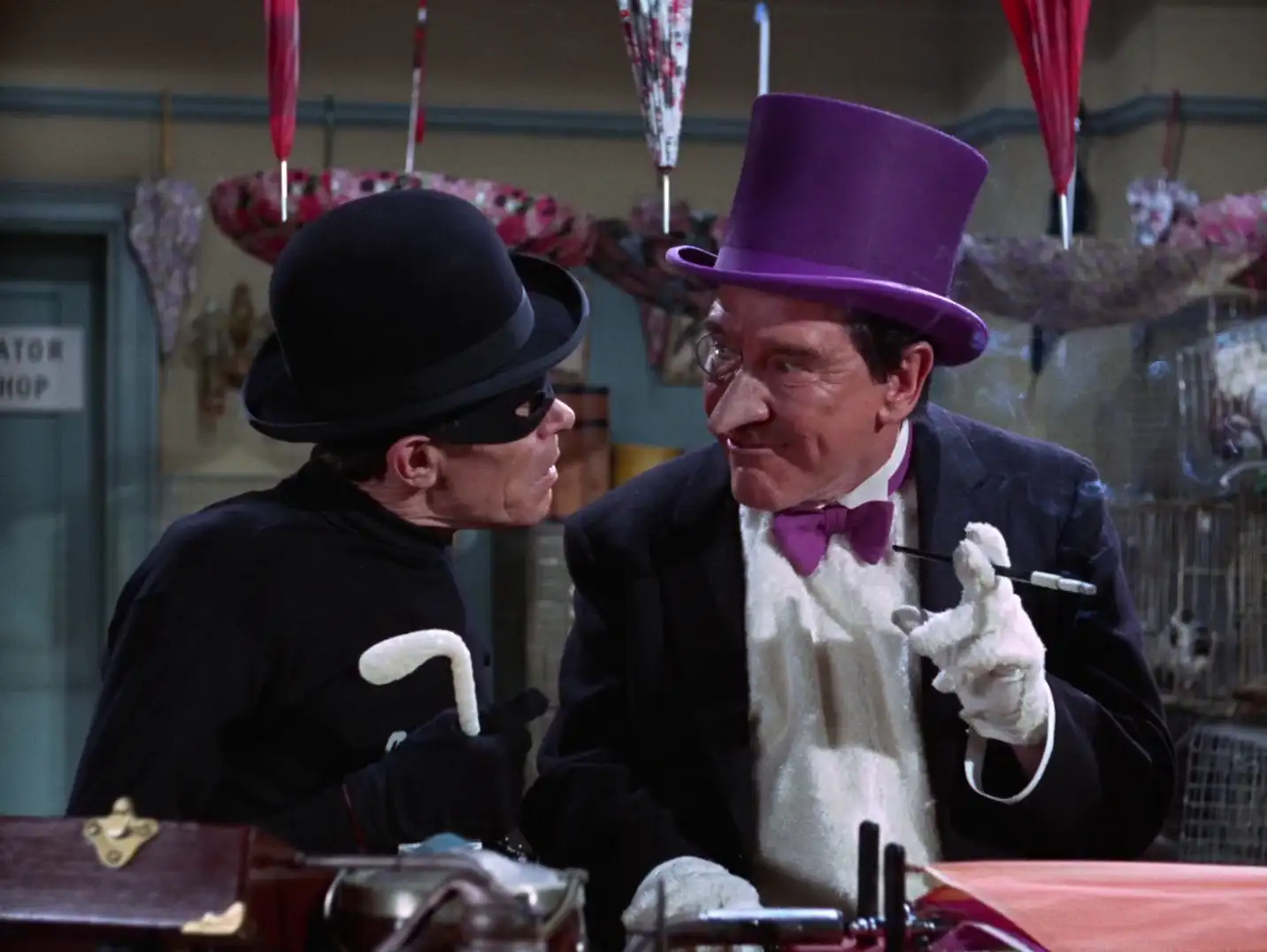 Despite being a show about superheroes and supervillains, very few characters in the 1960s Batman series actually possess superpowers. Almost everyone relies on gadgets, gimmicks, and theatrical flair rather than genuine abilities. The show never bothers to explain why the Joker looks like a clown or why the Penguin has such an exaggerated nose—they just are that way. In the first two seasons, only Mr. Freeze could really be called a “supervillain”, since his condition requires subzero temperatures to survive. A few others flirt with the idea of having powers, like False Face, who can impersonate anyone; the Siren, who can hypnotize men with her voice; and Dr. Cassandra, who uses a pill to turn invisible.
Despite being a show about superheroes and supervillains, very few characters in the 1960s Batman series actually possess superpowers. Almost everyone relies on gadgets, gimmicks, and theatrical flair rather than genuine abilities. The show never bothers to explain why the Joker looks like a clown or why the Penguin has such an exaggerated nose—they just are that way. In the first two seasons, only Mr. Freeze could really be called a “supervillain”, since his condition requires subzero temperatures to survive. A few others flirt with the idea of having powers, like False Face, who can impersonate anyone; the Siren, who can hypnotize men with her voice; and Dr. Cassandra, who uses a pill to turn invisible.
Most villains, however, depend on their inventions and props to commit crimes. At one point, the Joker even creates a device capable of stopping and reversing time. You can’t help but wonder—if he can build that, why turn to crime at all? He could’ve made a fortune patenting his inventions! It’s this kind of logic (or lack thereof) that makes the show so gloriously campy—and so easy to poke fun at.
 The classic rogues—Joker, Penguin, Riddler, and Catwoman—remain the best of the bunch, and it’s no coincidence they’re also the most frequently featured. As a kid, the Riddler was always my favorite, but as an adult, Julie Newmar’s Catwoman easily takes that spot—for reasons that probably don’t need much explaining. Beyond the core villains, a few others manage to stand out. King Tut, who didn’t impress me much at first, really grew on me over time. Egghead might be one of the silliest villains in the series, but Vincent Price’s sheer charisma makes him unforgettable—I just wish he’d appeared in more episodes. The Mad Hatter and the second incarnation of Mr. Freeze (the character was portrayed by three different actors in total) also delivered memorable turns worth highlighting.
The classic rogues—Joker, Penguin, Riddler, and Catwoman—remain the best of the bunch, and it’s no coincidence they’re also the most frequently featured. As a kid, the Riddler was always my favorite, but as an adult, Julie Newmar’s Catwoman easily takes that spot—for reasons that probably don’t need much explaining. Beyond the core villains, a few others manage to stand out. King Tut, who didn’t impress me much at first, really grew on me over time. Egghead might be one of the silliest villains in the series, but Vincent Price’s sheer charisma makes him unforgettable—I just wish he’d appeared in more episodes. The Mad Hatter and the second incarnation of Mr. Freeze (the character was portrayed by three different actors in total) also delivered memorable turns worth highlighting.
I’ll go into more detail on each of these villains when I take a closer look at the show season by season.
Dated
Being a 60-year-old TV show, Batman naturally comes with plenty of dated elements. Batman’s “cutting-edge” technology is particularly amusing in hindsight, as many of his once-futuristic gadgets now feel quaint—or are even common features on a modern smartphone. The special effects, while decent for the time, rarely attempt anything too ambitious. The notable exceptions tend to involve deadly animals, sometimes with hilarious results. The silliest has to be a giant man-eating clam, but there are also moments where Batman and Robin face off against painfully obvious fake tarantulas or a handful of rubber crocodiles. In the final season, a toy bee is passed off as a real one—a moment that perfectly captures the show’s low point in special effects. At least they did go all out in some cases, like using a real tiger in a Catwoman episode cliffhanger, proving they weren’t entirely averse to practical danger.
 The wardrobe is unmistakably ’60s, and Batman and Robin’s costumes are essentially colorful pajamas, offering zero real protection during combat. In the first two seasons, the outfits stay fairly neutral, sticking to the classic comic-inspired look. By the final season, however, the Flower Power era makes its presence felt, noticeably influencing Bruce and Dick’s wardrobes with brighter colors and more flamboyant styling—a clear nod to the changing fashions of the late 1960s.
The wardrobe is unmistakably ’60s, and Batman and Robin’s costumes are essentially colorful pajamas, offering zero real protection during combat. In the first two seasons, the outfits stay fairly neutral, sticking to the classic comic-inspired look. By the final season, however, the Flower Power era makes its presence felt, noticeably influencing Bruce and Dick’s wardrobes with brighter colors and more flamboyant styling—a clear nod to the changing fashions of the late 1960s.
What also marks this show as very much a product of its era is how it handles women and minorities. Batman is decidedly a man’s show. Among the central cast, there’s only one woman: Aunt Harriet, whose role is largely limited to remaining oblivious to Bruce and Dick’s secret identities. Much of her screen time revolves around the heroes inventing excuses to skip dinner dates or museum visits without blowing their cover.
The pattern is similar among the villains. Catwoman is the only recurring female antagonist, appearing in episodes across multiple seasons. Beyond her, female villains are rare. In the first two seasons, only a handful make appearances as one-off adversaries: Zelda the Great, Ma Parker, Black Widow, and Marsha, Queen of Diamonds. Their scarcity highlights just how male-centered the show truly is.
 The third season introduces Batgirl—and with her comes a slightly larger roster of female villains—but they never feel like they were added because of her presence. Most of these women never actually participate in the fight scenes, instead standing off to the side while their henchmen clash with Batman and Robin. Even Catwoman, a character who clearly looks capable of holding her own, is often sidelined during the action.
The third season introduces Batgirl—and with her comes a slightly larger roster of female villains—but they never feel like they were added because of her presence. Most of these women never actually participate in the fight scenes, instead standing off to the side while their henchmen clash with Batman and Robin. Even Catwoman, a character who clearly looks capable of holding her own, is often sidelined during the action.
Batgirl is the only female combatant, yet her fighting style is peculiar. She rarely throws a punch, instead relying on kicks or improvised hits using whatever props happen to be on set—flower pots, brooms, anything within reach. It’s a quirky choice that underscores the show’s campy, almost slapstick approach to female characters in action sequences.
Aside from a few exceptions, the women in Batman are almost always part of the gang of that week’s male villain. Every antagonist seems to have at least one astonishingly beautiful woman at his side, and not infrequently, these women harbor romantic—or at least flirtatious—feelings for Batman. At the conclusion of each story, they typically receive little more than a slap on the wrist, framed as innocent victims swept up in the villain’s schemes. Batman often reflects on how these “good girls” were led astray by the likes of the Joker, Penguin, or Riddler, emphasizing that they were merely pawns in a greater evil.
Even Zelda the Great, who kidnapped Aunt Harriet and left her dangling above an open fire, is portrayed as a woman coerced by a man. In the final scene, Bruce Wayne visits her in jail, offering her a fresh start. In Batman, women are generally seen as innocent, and if they stray into criminality, it’s always implied that someone or something forced them down that path. Male villains, by contrast, are almost always portrayed as evil for the sheer enjoyment of it. The only exception is Catwoman, whose relationship with Batman is unique, granting her a dynamic that earns her a special place in his affections and adds layers to her character.
 The third season also includes a painfully dated and extremely sexist episode in which Nora Clavicle, a feminist activist, becomes the “villain of the week.” In the story, she replaces Commissioner Gordon as head of the police and fills the force with women who, instead of focusing on crime-fighting, are more preoccupied with things like lipstick and their appearance. Watching it in 2025, the episode is a difficult—and almost unbelievable—reminder of just how out of step the show could be with gender sensibilities, making it a cringe-worthy moment that truly has to be seen to be believed.
The third season also includes a painfully dated and extremely sexist episode in which Nora Clavicle, a feminist activist, becomes the “villain of the week.” In the story, she replaces Commissioner Gordon as head of the police and fills the force with women who, instead of focusing on crime-fighting, are more preoccupied with things like lipstick and their appearance. Watching it in 2025, the episode is a difficult—and almost unbelievable—reminder of just how out of step the show could be with gender sensibilities, making it a cringe-worthy moment that truly has to be seen to be believed.
Batman premiered just a year after Black Americans gained the right to vote nationwide, so it’s perhaps unsurprising that the show lacks any meaningful diversity. All of the central characters are white, and the only Latin actor in the main cast, Cesar Romero, appeared as the Joker wearing heavy white makeup. It wouldn’t be until the third season that Catwoman would be played by a Black actress, Eartha Kitt.
On the positive side, the show’s lack of diversity at least avoided some of the overtly harmful racial stereotypes common in media at the time. There are no instances of Black men being portrayed as criminals targeting white victims; virtually all the crime depicted is “white-on-white.” There is only a single episode where a villain has a Black henchman.
The series does include two episodes featuring Native American characters, though both are played by white actors and rely on outdated, stereotypical depictions. Unfortunately, one of these episodes features Egghead—a character otherwise so much fun and memorable—making it a particularly awkward and regrettable misstep.
The language in Batman also feels decidedly antiquated. Batman frequently refers to Robin as “old chum” throughout the series, a charmingly old-fashioned term that immediately marks the show as a product of its era. The rising hippie culture of the late ’60s even seeps into the final season, with episodes mentioning—or even featuring—hippies, and tossing in slang like “groovy” to signal the times.
Certain terms the show uses today feel particularly strange. Bruce is constantly referred to as “Millionaire Bruce Wayne,” as if his wealth alone defines him. Alfred calls him this when speaking of his employer, Gordon uses it when referring to him as a friend, and even the villains routinely use the same phrasing. Often it’s followed by “and his youthful ward Dick Grayson,” creating an even sillier way to address someone—who, in reality, would ever constantly define people by their relationship like that?
With all that context, it’s time to take a closer look at the show on a season-by-season basis:
Season 1
The first season essentially establishes the Batman formula as we know it: 34 two-part episodes, each following the same familiar pattern. Every week, a colorful villain is showcased, portrayed by a special guest star, while Batman and Robin work to foil their schemes. This season features the following villains:
- The Riddler
- The Penguin
- The Joker
- Mr. Freeze
- Zelda the Great
- The Mad Hatter
- False Face
- Catwoman
- King Tut
- The Bookworm
 A few actors really stand out among the season’s villains. Burgess Meredith shines as The Penguin, a role that would cement his place in pop culture long before he became famous as Mickey, Rocky’s trainer. Julie Newmar is absolutely stunning as the seductive Catwoman, the only recurring villain who consistently manages to escape Batman’s grasp at the end of her two episodes. Roddy McDowall, best known from Planet of the Apes, takes on the more obscure role of The Bookworm.
A few actors really stand out among the season’s villains. Burgess Meredith shines as The Penguin, a role that would cement his place in pop culture long before he became famous as Mickey, Rocky’s trainer. Julie Newmar is absolutely stunning as the seductive Catwoman, the only recurring villain who consistently manages to escape Batman’s grasp at the end of her two episodes. Roddy McDowall, best known from Planet of the Apes, takes on the more obscure role of The Bookworm.
Honorable mentions go to Cesar Romero and Frank Gorshin as The Joker and The Riddler, respectively. The Riddler has always been my favorite character, and even 60 years later, Frank Gorshin’s manic energy keeps him endlessly entertaining. Romero’s Joker is a solid interpretation, though the show softens him into more of a “Riddler-light,” swapping riddles for jokes and dialing down some of the manic intensity in favor of campy charm.
 There are several standout episodes in the first season. “The Joker Goes to School/He Meets His Match, the Grisly Ghoul” gives a rare glimpse into Dick Grayson’s everyday life at school, even having him go undercover as a greaser to infiltrate the Joker’s gang. “The Purr-fect Crime/Better Luck Next Time” features Catwoman and highlights her unique dynamic with the Caped Crusader—Julie Newmar’s skintight outfit was likely a teenage fantasy back in the day.
There are several standout episodes in the first season. “The Joker Goes to School/He Meets His Match, the Grisly Ghoul” gives a rare glimpse into Dick Grayson’s everyday life at school, even having him go undercover as a greaser to infiltrate the Joker’s gang. “The Purr-fect Crime/Better Luck Next Time” features Catwoman and highlights her unique dynamic with the Caped Crusader—Julie Newmar’s skintight outfit was likely a teenage fantasy back in the day.
False Face is another intriguing villain in this season, with his ability to instantly mimic anyone hinting at actual superpowers, setting him apart from the more gadget-reliant rogues. “The Penguin Goes Straight/Not Yet, He Ain’t” is also memorable, showing the Penguin attempting to go straight—an amusing twist that would later echo in films like Batman Returns, where Penguin similarly tries to present himself as a legitimate figure.
 One villain worth highlighting is the Bookworm. He’s portrayed as a nerdy character, and both he and his henchmen wear glasses—a detail that becomes part of a running joke. During the inevitable showdown with Batman and Robin, Batman refuses to strike anyone wearing glasses, which is a humorous touch. What’s even more interesting is the Bookworm’s behavior in these confrontations. Unlike most male villains, who actively participate in the fight, he hides wherever he can—often in a dumpster—essentially acting like a coward.
One villain worth highlighting is the Bookworm. He’s portrayed as a nerdy character, and both he and his henchmen wear glasses—a detail that becomes part of a running joke. During the inevitable showdown with Batman and Robin, Batman refuses to strike anyone wearing glasses, which is a humorous touch. What’s even more interesting is the Bookworm’s behavior in these confrontations. Unlike most male villains, who actively participate in the fight, he hides wherever he can—often in a dumpster—essentially acting like a coward.
This contrasts sharply with other male villains, who usually throw themselves into the action. However, the series would later turn this “standing on the sidelines” behavior into a recurring trope for female villains. In subsequent seasons, women frequently watch their henchmen battle Batman and Robin instead of fighting themselves—and occasionally, male villains like King Tut adopt the same passive approach.
Season 2
The second season is a massive undertaking, consisting of a whopping 60 episodes, and it’s here that the show begins to feel noticeably repetitive. Part of the problem is that many of the early villains are fairly lackluster, with the series taking its sweet time bringing back the A-listers and instead focusing on lesser-known characters—some created specifically for the show—during the first quarter of the season.
 Notably absent is the Riddler, the villain who kicked off the series; Frank Gorshin was reportedly tied up in a contract dispute. He’s eventually replaced near the end of the season by John Astin—famously Gomez Addams—in a two-parter. Astin’s Riddler is a curious take, essentially a bargain-bin version of the original, almost like “what if you bought the Riddler on Temu?” The season also features The Puzzler, a cheap knockoff of the Riddler, as to him what a Go-Bot is to a Transformer.
Notably absent is the Riddler, the villain who kicked off the series; Frank Gorshin was reportedly tied up in a contract dispute. He’s eventually replaced near the end of the season by John Astin—famously Gomez Addams—in a two-parter. Astin’s Riddler is a curious take, essentially a bargain-bin version of the original, almost like “what if you bought the Riddler on Temu?” The season also features The Puzzler, a cheap knockoff of the Riddler, as to him what a Go-Bot is to a Transformer.
This season introduces a whole slew of new villains, most of whom appear in only a single two-parter. The following new villains make their debut in season two:
- Archer
- The Minstrel
- Ma Parker
- The Clock King
- Egghead
- Chandell
- Marsha, the Queen of Diamonds
- Shame
- The Puzzler
- The Sandman
- Colonel Gumm
- Black Widow
 The show’s trademark cliffhanger endings are arguably its weakest link. Typically, Batman and Robin lose a fight and end up in absurdly over-the-top traps—one famously involving a giant man-eating clam that swallows Robin whole. The problem is that these cliffhangers are almost always resolved quickly and in equally ridiculous fashion. When Batman falls into a vat of sulfuric acid, for example, he survives because Alfred had just recently crafted new acid-proof costumes—an explanation both convenient and comically arbitrary. Most escapes make little logical sense and rely on deus ex machina gadgets that are never mentioned before and almost never seen again, highlighting the show’s campy, cartoonish approach to peril.
The show’s trademark cliffhanger endings are arguably its weakest link. Typically, Batman and Robin lose a fight and end up in absurdly over-the-top traps—one famously involving a giant man-eating clam that swallows Robin whole. The problem is that these cliffhangers are almost always resolved quickly and in equally ridiculous fashion. When Batman falls into a vat of sulfuric acid, for example, he survives because Alfred had just recently crafted new acid-proof costumes—an explanation both convenient and comically arbitrary. Most escapes make little logical sense and rely on deus ex machina gadgets that are never mentioned before and almost never seen again, highlighting the show’s campy, cartoonish approach to peril.
Another curious quirk of the show is that, even when villains incapacitate Batman and Robin at the end of the first half, not a single one ever bothers to remove Batman’s cowl and discover his true identity. You’d think that would be the first thing any masked vigilante’s enemy would do when he’s lying unconscious at their feet. Yet, throughout the entire series, Batman’s secret identity is only a concern for a villain about four times—an odd oversight that underscores the show’s commitment to lighthearted, almost cartoonish storytelling over realism or tension.
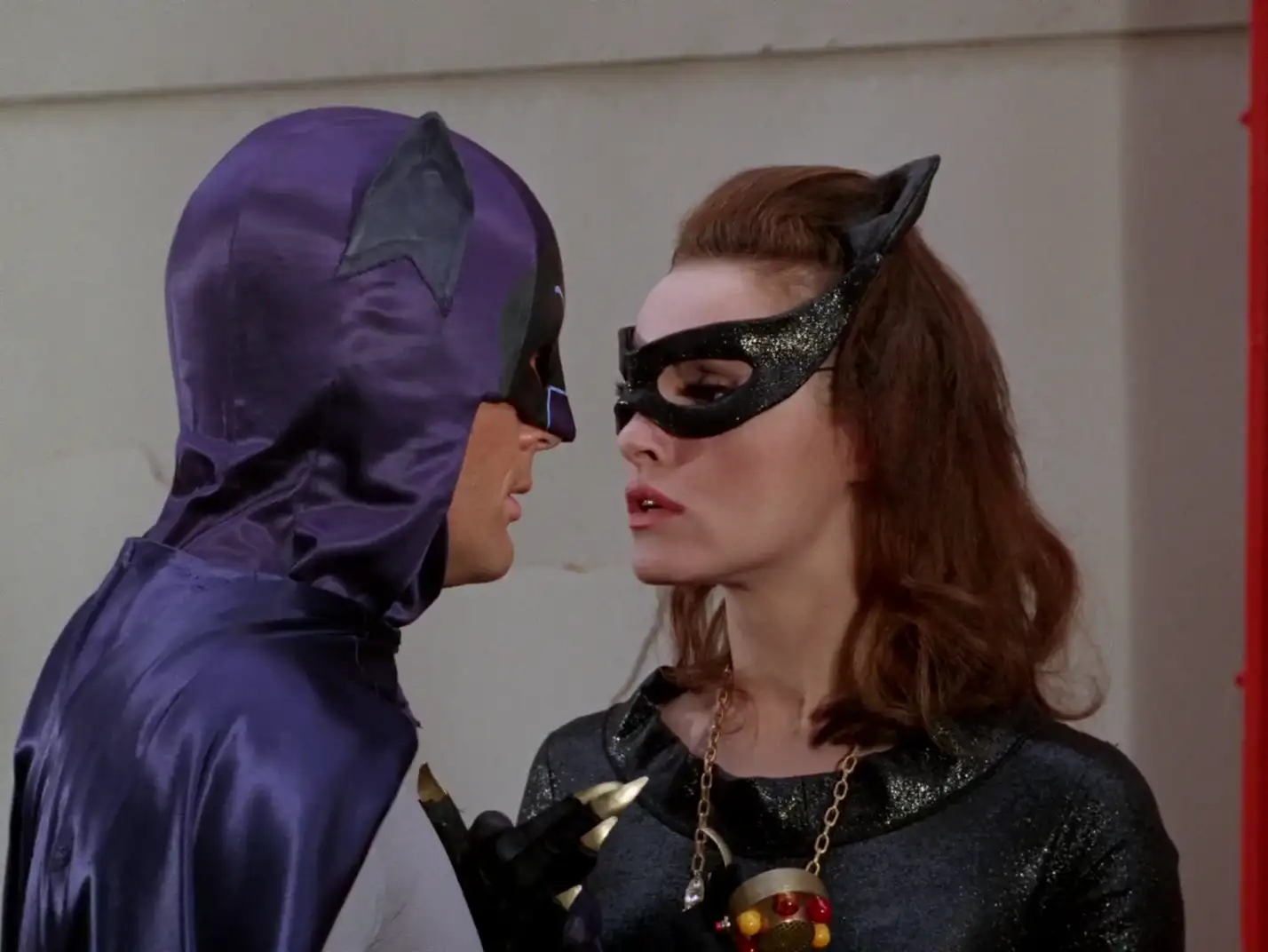 The standout villain of this season is undoubtedly Catwoman. Partly, of course, because Julie Newmar is absolutely stunning, but also because the season develops a palpable sexual tension between her and Batman—something mostly absent in the first season. Batman is clearly infatuated with her, and it’s easy to see why. This dynamic sets her apart from every other villain, even though the season introduces a number of additional female antagonists. Catwoman’s combination of charm, cunning, and flirtation creates a unique and memorable interplay that elevates her above the rest.
The standout villain of this season is undoubtedly Catwoman. Partly, of course, because Julie Newmar is absolutely stunning, but also because the season develops a palpable sexual tension between her and Batman—something mostly absent in the first season. Batman is clearly infatuated with her, and it’s easy to see why. This dynamic sets her apart from every other villain, even though the season introduces a number of additional female antagonists. Catwoman’s combination of charm, cunning, and flirtation creates a unique and memorable interplay that elevates her above the rest.
The classic villains remain as reliable as ever. Burgess Meredith’s Penguin and Cesar Romero’s Joker steal every scene they appear in, bringing charisma and energy that elevate their episodes. Other returning villains, like Mr. Freeze and King Tut, are less memorable, lacking the same flair.
Among the new villains, most are serviceable but forgettable, though it’s clear the actors are having a blast playing these roles. Vincent Price as Egghead is a highlight, clearly relishing every moment, as is Tallulah Bankhead as Black Widow in what would be her final role. On the downside, some characters—like Shame, an obvious parody of Shane—are little more than a villain in western clothing with no real impact. At least some new villains come with interesting gadgets that make them somewhat threatening: Joker’s ability to stop and rewind time, or Catwoman’s knack for stealing voices, add a bit of excitement to the otherwise goofy antics.
The window cameos, which were introduced late in the first season, become a regular feature here, often showcasing celebrities of the ’60s like Sammy Davis Jr. or fictional icons such as the Green Hornet and Kato. In fact, the Green Hornet and Kato have full supporting roles at the end of the season, and in the episode’s opening scene, Bruce Lee as Kato delivers fight choreography that far surpasses anything else in the series.
This season leans heavily on quantity over quality, but the sheer silliness of the show keeps it consistently entertaining, even if not every episode lands. There are moments that could easily qualify as “jumping the shark,” yet it also delivers one of the series’ best scenes: Batman having a phone call with Bruce Wayne. It’s pure gold, and Adam West shines in his role as the ultimate boy scout, dutifully lecturing Robin on everything from fastening his seatbelt to always obeying the law—a rather dubious moral stance given America’s racist past and the legal realities of the era. The cracks in the show’s formula are becoming apparent, setting the stage for a big makeover in season three.
Season 3
The third season shakes things up right from the start. The most significant changes are the introduction of Batgirl and the shift to single, self-contained episodes rather than two-parters. It doesn’t sound like a major change on paper, but it completely alters the show’s rhythm—for better and for worse. The reduced runtime forces the stories to be more concise, giving each villain only about 26 minutes to unleash chaos on Gotham City. As a result, their schemes are usually smaller in scale than in previous seasons.
 Earlier seasons often suffered from thin plots being stretched over two episodes, such as the tedious storyline of the Joker trying to break into the art world late in season two. Now, everything moves at a brisker pace. The trade-off is that some of the show’s most delightfully bizarre moments emerge—like the Riddler facing Batman in a boxing match or the Joker taking him on in a surfing contest. These absurd scenarios perfectly capture the campy energy the series fully embraces at this stage.
Earlier seasons often suffered from thin plots being stretched over two episodes, such as the tedious storyline of the Joker trying to break into the art world late in season two. Now, everything moves at a brisker pace. The trade-off is that some of the show’s most delightfully bizarre moments emerge—like the Riddler facing Batman in a boxing match or the Joker taking him on in a surfing contest. These absurd scenarios perfectly capture the campy energy the series fully embraces at this stage.
While familiar faces like the Riddler and Joker make their return, season three still introduces plenty of new villains across its 26 episodes:
- Lorelei Circe, aka The Siren
- Lola Lasagne
- Louie the Lilac
- Olga, Queen of the Bessarovian Cossacks
- Lord Ffogg and Lady Peasoup
- Nora Clavicle
- Dr. Cassandra
- Minerva
Too bad none of these new villains are actually great. The third season really leans on the established rogues to keep things entertaining, with Egghead once again stealing every scene he’s in and King Tut becoming surprisingly enjoyable in his final appearances. Unfortunately, Shame also makes an unwelcome return—and in a two-parter, no less. Among the new additions, Lord Ffogg and Lady Peasoup stand out for all the wrong reasons. They headline the only three-parter of the season, which takes Batman “across the pond” to Londinium. It’s easily the weakest storyline of the season and feels like a bit of a middle finger to the cast, who are still performing on cheap U.S. sets with stock footage of London awkwardly inserted to make it seem like Batman is fighting crime in Europe.
That said, the season does introduce something new: villains with actual superpowers. Up until this point, most of Batman’s foes were just themed crooks with gimmicks and gadgets, but now we get a few who actually cross into the realm of the supernatural. The Siren, for instance, has a hypnotic voice that can bend men to her will, while Dr. Cassandra can make herself invisible—and even frees several of Batman’s classic foes in the show’s penultimate episode. These moments hint at what the series could have explored further, had it continued beyond this final season.
Because the show was faltering in the ratings and most episodes were now standalone stories, the budget took a noticeable hit—especially when it came to the sets. The once-frequent glimpses of Wayne Manor became rarer, and while a few new locations like Batgirl’s apartment were introduced, it’s the villain lairs that suffered the most. In the earlier seasons, these hideouts were elaborate and full of character, often feeling like genuine extensions of the villains’ personalities. By contrast, the third season’s sets look cheap and hastily thrown together—usually just a few themed props in the foreground with a flat black wall behind them. It’s painfully clear the production was reusing the same stage each week, swapping out decorations rather than designing unique, believable environments.
 The addition of Batgirl feels like a last-ditch effort to inject new life into the show—and while her character is likable, the execution doesn’t quite work. Her inclusion forces the writers into awkward narrative corners, as they constantly need to justify her presence. Neither Batman nor Commissioner Gordon have any idea who she is or how to contact her, which is especially odd considering Bruce Wayne is shown dating Barbara, who is also Gordon’s daughter. So much for the world’s greatest detective.
The addition of Batgirl feels like a last-ditch effort to inject new life into the show—and while her character is likable, the execution doesn’t quite work. Her inclusion forces the writers into awkward narrative corners, as they constantly need to justify her presence. Neither Batman nor Commissioner Gordon have any idea who she is or how to contact her, which is especially odd considering Bruce Wayne is shown dating Barbara, who is also Gordon’s daughter. So much for the world’s greatest detective.
Villains suddenly develop a suspicious fascination with the Gotham City Library—Barbara’s workplace—simply to give Batgirl an excuse to appear in each episode. Her character might have worked far better had the show remained an hour long, allowing more time to establish a closer connection between her and the Dynamic Duo.
Batgirl also suffers from her own personal theme song, which is used sparingly for good reason—it’s a cringe-inducing piece of music that feels wildly out of place compared to the otherwise catchy score of the series. The overall soundtrack of the third season also takes a noticeable dip in quality.
While Batgirl serves as a positive role model for young girls, the show simultaneously frames her as an object of attraction for male viewers. Her skintight costume, designed to emphasize her figure, gives the show a dose of sex appeal that previously only appeared in Julie Newmar’s Catwoman episodes.
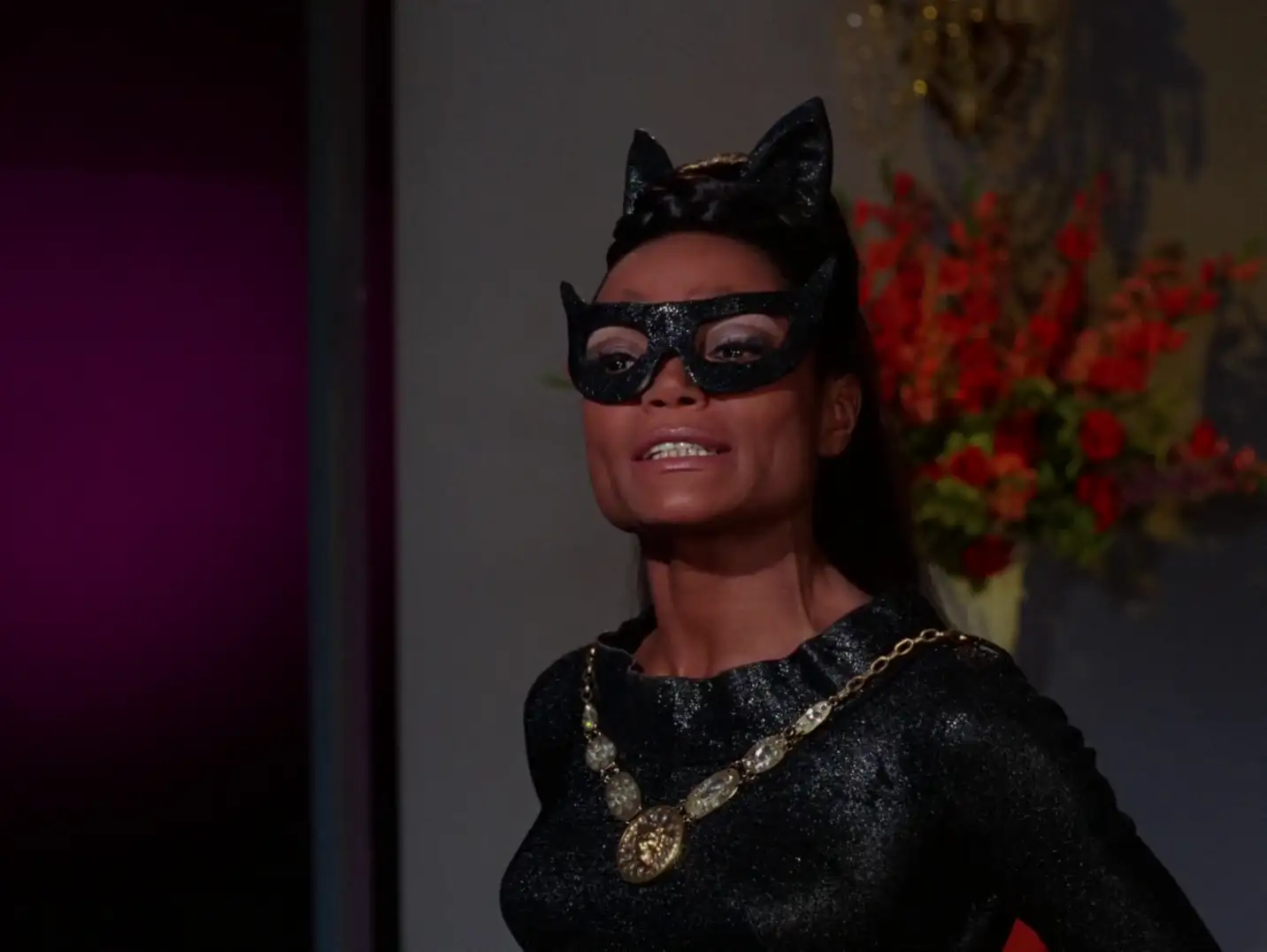 Speaking of which, Julie Newmar’s absence in the third season is keenly felt, with African American actress Eartha Kitt stepping into the role of Catwoman. Her casting was nothing short of groundbreaking for its time. As previously mentioned, Batman was an overwhelmingly white show, and outside of one of Joker’s henchmen in the UFO episode, Kitt is the only person of color to appear in a major role—let alone as a lead villain. Having her play Catwoman marked the first true instance of a race swap in mainstream television, something that would only become commonplace decades later.
Speaking of which, Julie Newmar’s absence in the third season is keenly felt, with African American actress Eartha Kitt stepping into the role of Catwoman. Her casting was nothing short of groundbreaking for its time. As previously mentioned, Batman was an overwhelmingly white show, and outside of one of Joker’s henchmen in the UFO episode, Kitt is the only person of color to appear in a major role—let alone as a lead villain. Having her play Catwoman marked the first true instance of a race swap in mainstream television, something that would only become commonplace decades later.
Kitt only appears in three episodes, and in two of those, she has to share the spotlight with the Joker. Yet even with limited screen time, she completely makes the role her own. Her Catwoman is sharper, fiercer, and more predatory than Newmar’s—a portrayal that emphasizes menace over seduction. Unfortunately, that shift also means the flirtatious chemistry between Batman and Catwoman, so central to Newmar’s interpretation, is gone. A romantic spark between a white male hero and a black female villain was clearly considered too controversial for 1960s network television.
 Personally, I still prefer Newmar’s take on the character. She had more screen time to develop the role and brought an irresistible mix of charm, wit, and sensuality that’s hard to top. That said, Kitt’s version remains historically significant. Her casting challenged racial boundaries in American television and paved the way for more diverse and inclusive interpretations of classic characters in the decades that followed.
Personally, I still prefer Newmar’s take on the character. She had more screen time to develop the role and brought an irresistible mix of charm, wit, and sensuality that’s hard to top. That said, Kitt’s version remains historically significant. Her casting challenged racial boundaries in American television and paved the way for more diverse and inclusive interpretations of classic characters in the decades that followed.
Conclusion
In many ways, Batman is a timeless show. You can show it to a young kid today and they’ll still find it entertaining. As an adult, I had a great time revisiting it—though mostly as a campy comedy rather than a serious superhero series. It’s unapologetically goofy, full of over-the-top villains, nonsensical plots, and absurd contraptions. Yet there’s an undeniable charm to it all. Many of the performances are so distinct and memorable that you can still see traces of them in modern live-action portrayals of these iconic characters.
The show’s legacy can’t be overstated either. Its exaggerated tone and comedic sensibilities eventually sparked a backlash among comic book writers, who reimagined Batman as a darker, more brooding figure—a shift that would redefine the character for decades. In a way, every serious adaptation of Batman since has been a reaction against this version. Tim Burton’s Batman in 1989 was a deliberate course correction, grounding the character in gothic darkness. Joel Schumacher’s Batman Forever and Batman & Robin, on the other hand, were colorful, campy love letters to this 1960s show. And then came Christopher Nolan’s Dark Knight trilogy, which swung the pendulum all the way back to gritty realism.
So while the 1960s Batman might not be the version fans want to see remade, it’s the foundation that made every later reinvention possible. Without the “Bam!”, “Pow!”, and “Zap!” era, we wouldn’t have the Batman we know today.






